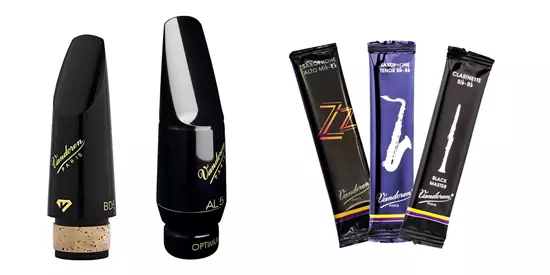Reeds, Reeds, Reeds!

Have you ever had one of those “bad reed days”? The days where every reed you try just seems to sound awful? Or you’ve just opened a new pack and it seems like each reed is too stiff and your tone is suffering because of this? You are not alone.
As a woodwind player who has played woodwind instruments for over fifteen years, I have come across many ways that single-reed and double-reed instrumentalists can demystify how to prolong reed life, and to keep them playing in optimal condition for a longer period of time. My hope with this article is to provide clarity in helping to find suitable reeds for all levels of players.
Let’s start with the biggest problem: there is an overwhelming selection of reeds to choose from.
It actually all comes down to the mouthpiece you play, to start. Each mouthpiece adheres to a specific tip opening classification. Some are more closed and some are more open from the tip of reed. This is why reed thicknesses vary. Thinner reeds pair well with more open tip openings. Thicker reeds pair well with more closed tip openings. Each mouthpiece manufacturer has a different classification system, usually combinations of numbers and letters. In the case of Vandoren mouthpieces, for example, they suggest reed strengths and combinations on the packaging of their mouthpieces that follow the thin/open, thick/closed principle. If you do not know where your current mouthpiece lies in this classification, it is best to check the manufacturer’s website and find the model. Most manufacturers have downloadable versions of their mouthpiece charts.
Upgrade your mouthpiece ligature and reeds
As well as thickness variations, each reed manufacturer usually has an assortment of different cuts to their reeds. The slope of the reed, the angle of the scrape and the shape of the tip are considered. It is these differences that produce more tonal opportunities. But we can simplify this by categorizing reeds into two basic groups: filed and unfiled.
A filed reed, sometimes also called a French-file, takes one extra scrape at the shoulder of the reed. This extra scrape allows the reed to vibrate further down the reed, thus allowing for slightly more volume and a little less resistance. An unfiled reed takes after the traditional method of reed making which keeps the shoulders intact. These reeds are typically slightly more resistant but offer a solid core to the sound.
So what reeds work for you? The only way to find out is to try them! Easier said than done. However, by taking the above recommendations and understanding what sound you are looking for, your search for your ideal reed should not be too difficult.
In the case of double reeds, for oboe and bassoon, many teachers make reeds for their students. Since crafting reeds can be time-consuming, sometimes purchasing a thicker-than-usual oboe or bassoon reed can be beneficial for a teacher and for a student. Teachers can introduce basic shaving and filing techniques to their students to adjust these pre-made reeds to their liking. Students who play double-reed instruments eventually learn the discipline of personal reed crafting.
Synthetic reeds, such as those made by Legere, are great for longevity, as they play very consistently and are always at the ready since you don’t have to soak them. The company makes them for just about all woodwinds, and recently just came out with an oboe reed, which I personally enjoy playing. I would recommend Legere reeds to an intermediate or pro-level player whose demands on their instrument warrant very frequent playing and their reed will always be ready to play when they need it.
Here are some helpful ways to aid in the preservation and longevity of your wooden reeds:
- Probably the most important tip, when opening a pack of reeds, is to soak them all at the same time and rotate playing them so that you have more reeds that have been broken in, rather than using one till its last leg and having to break in another. Reeds are like shoes – they have a break-in period, a period in which they are optimal, and then they stop working well. The idea is to have more reeds in an optimal playing condition.
- Though a bit of an old trick, putting orange peels in a plastic bag with your reeds aids in making sure your reeds don’t dry out too much or too quickly. It also stabilizes the overall humidity of your reeds if you do not have a reed case with a humidifier. D’Addario makes a reed case for woodwind reeds that also houses a humidifier pack - which works the same way the orange peels do!
- Rubbing the flat side of the reed against 800 to 1000 grit sandpaper will help loosen the fibres and straighten out any discrepancies in the smoothness underneath the reed.
- While playing, if your reed is sounding dull, it can be either too wet or not wet enough – to help with this, run your nail up and down the heart of the reed to loosen the fibres and help the reed “breathe.”
- Always keep your reeds in a reed pack. If you have many left over, you can actually refrigerate them so that they don’t get too dry in their boxes.
Protect your reeds with these reed cases
***
Kishan Chouhan obtained a BA in Clarinet Performance at the University of Toronto, and an MA at York University with research in woodwind performance and pedagogy. He plays flute, piccolo, clarinet, saxophones, oboe, English horn and bassoon in musical theatre pit orchestras across Toronto. He also has orchestral experience on all woodwind instruments. Kishan is the Assistant Manager at Long & McQuade Scarborough.









